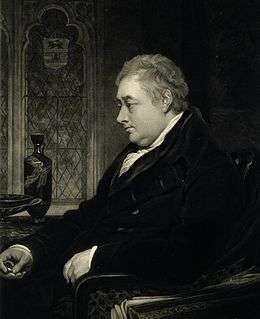Henry Englefield

Sir Henry Charles Englefield, 7th Baronet FRS FRSE FSA FLS (1752 – 21 March 1822) was an English antiquary and scientist.
Life
He was born at the family mansion, Englefield House, near Reading, the eldest son of Sir Henry Englefield (d.1780), sixth baronet, by his second wife, Catherine, daughter of Sir Charles Bucke, Bart. His father, who was the son of Henry Englefield, of Whiteknights Park at Earley near Reading, Berkshire, had in 1728 succeeded to the title and the Engelfield estates at Wooton Basset, Wiltshire; so that Henry Charles inherited both Whiteknights and Wooton Basset on the death of his father, 25 May 1780.
He never married, and devoted his entire life to study. In 1778 at the early age of 26 he was elected a Fellow of the Royal Society, and in the following year Fellow of the Society of Antiquaries. For many years he was vice-president of the latter, and succeeded the Marquess Townshend as president. Owing, however, to his being a Catholic, objection was taken to his re-election; another factor was his opposition to the 1797 election to the Society of the architect James Wyatt.[1] He was replaced by the Earl of Aberdeen. Under his direction the society produced between 1797 and 1813 the series of engravings of English cathedrals, to which series he contributed the dissertations on Durham, Gloucester, and Exeter.
In 1781 Englefield joined the Dilettanti Society and acted as its secretary for fourteen years. Besides his antiquarian studies, which resulted in many contributions to Archaeologia, he carried on research in chemistry, mathematics, astronomy, and geology. His "Discovery of a Lake from Madder" won for him the gold medal of the Society of Arts. He took no part in public life, owing to Catholic disabilities, but was intimate with Charles James Fox, and his cheerful temperament and vivacious conversation won him many friends. His portrait was painted by Sir Thomas Lawrence, and two bronze medals were struck bearing his likeness.
In Catholic affairs Englefield took a prominent part, being elected in 1782 a member of the Catholic Committee, formed by the laity for the promotion of Catholic interests, a body which subsequently found itself in conflict with the vicars Apostolic. In the early stages of this dispute he was one of the moving spirits and contributed the pamphlet, mentioned below, in answer to Dr. Horsley, the Anglican prelate. The latter afterwards became the friend of the Catholics, and it was through his influence that the Catholic Relief Bill of 1791 was modified to suit the requirements of the bishops. Throughout the dispute Englefield took an independent line, and at times went far in his opposition to the vicars Apostolic, as in 1792, when he was prepared to move a strong resolution at the general meeting of English Catholics. He was dissuaded at the last moment by the three who undertook to act as "Gentlemen Mediators" between the two parties. During his latter years his eyesight failed; he died at his house, Tilney St., London, the baronetcy thereupon becoming extinct.
He is buried in Englefield Churchyard.[2]
Works
His works are:
- "Tables of the Apparent Places of the Comet of 1661" (London, 1788);
- "Letter to the Author of 'The Review of the Case of the Protestant Dissenters'" (London, 1790);
- "On the Determination of the Orbits of Comets" (London, 1793);
- "A Walk Through Southampton" (Southampton, 1801);
- "Description of a New Transit Instrument, Improved by Sir H. Englefield" (London, 1814);
- "The Andrian, a Verse Translation from Terrence" (London, 1814);
- "Description of the Principal Beauties, Antiquities and Geological Phenomena of the Isle of Wight", with engravings from his own drawings, and a portrait (London, 1816);
- "Observations on the Probable Consequences of the Demolition of London Bridge" (London, 1821).
Joseph Gillow printed a list of papers contributed to the transactions of the Society of Antiquaries, Royal Society, Royal Institution, Society of Arts, and the Linnaean Society, as well as to Nicholson's Journal and Tilloch's Philosophical Magazine.
References
| Wikimedia Commons has media related to Henry Englefield. |
| Wikisource has original works written by or about: Henry Charles Englefield |
| Wikiquote has quotations related to: Henry Englefield |
- ↑ Sweet, Rosemary (2004) Antiquaries: The Discovery of the Past in Eighteenth-Century Britain, Bloomsbury Academic, ISBN 1852853093, pp. 104, 108.
- ↑ BIOGRAPHICAL INDEX OF FORMER FELLOWS OF THE ROYAL SOCIETY OF EDINBURGH 1783 – 2002 (PDF). The Royal Society of Edinburgh. July 2006. ISBN 0 902 198 84 X.
- Attribution
![]() This article incorporates text from a publication now in the public domain: Herbermann, Charles, ed. (1913). "Sir Henry Charles Englefield". Catholic Encyclopedia. New York: Robert Appleton.
This article incorporates text from a publication now in the public domain: Herbermann, Charles, ed. (1913). "Sir Henry Charles Englefield". Catholic Encyclopedia. New York: Robert Appleton.
External links
- Works by or about Henry Englefield in libraries (WorldCat catalog)